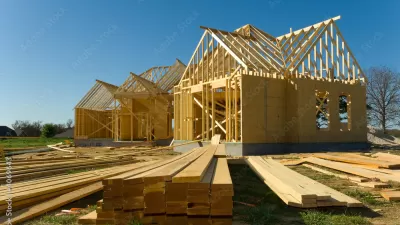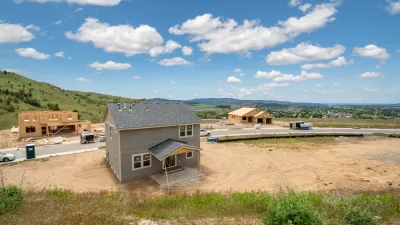The housing construction market is responding to strong demand with a glut of new single-family homes.

A January report by the National Association of Home Builders (NAHB) provides evidence of a new wave of single-family zoning in the United States as the home building industry overcame inflation worries, rising construction costs, and supply chain limitations to increase the number of housing starts to levels not seen since before the recession.
An article by Robert Dietz, published by NAHB, reveals details of the report, which shows large numbers of housing starts in both single-family housing and multi-family housing. Only homes with two to four units, a prominent typology of the missing middle targeted by zoning reforms in cities all over the country, declined.
Dietz summarizes the study:
Home building ended 2021 with strong annual gains as demand accelerated in the wake of the pandemic. These annual gains were realized despite supply-chain limitations for materials and ongoing access issues for labor and lots. Single-family starts ended 2021 with a 13.4% increase for a total of 1.123 million starts. Multifamily 5+ unit construction ended the year with a 22.1% gain, for a total of 460,100 starts. A component of the missing middle, 2 to 4 unit construction showed a decline for 2021, a 2.8% drop.
A news article picking up the story, written by Carlos Waters for CNBC, notes that last year's 1.123 million single-family housing starts is the highest number since 2006. Waters uses the new data as an opportunity to build the case against strict, exclusionary zoning rules, citing Ben Ross, author of Dead End: Suburban Sprawl and the Rebirth of American Urbanism to help make the case.
Waters's conclusion: "Today’s homebuyers are paying for past sprawl by drawing on credit to finance their lifestyles. Meanwhile, the cost of public infrastructure maintenance is weighing on depopulating towns across the country."
The NAHB's data about single-family starts echoes a recent report from Redfin that estimates one-third of all homes available for sale are new.
FULL STORY: Housing Starts End 2021 with Annual Gains

Study: Maui’s Plan to Convert Vacation Rentals to Long-Term Housing Could Cause Nearly $1 Billion Economic Loss
The plan would reduce visitor accommodation by 25,% resulting in 1,900 jobs lost.

Alabama: Trump Terminates Settlements for Black Communities Harmed By Raw Sewage
Trump deemed the landmark civil rights agreement “illegal DEI and environmental justice policy.”

Why Should We Subsidize Public Transportation?
Many public transit agencies face financial stress due to rising costs, declining fare revenue, and declining subsidies. Transit advocates must provide a strong business case for increasing public transit funding.

Paris Bike Boom Leads to Steep Drop in Air Pollution
The French city’s air quality has improved dramatically in the past 20 years, coinciding with a growth in cycling.

Why Housing Costs More to Build in California Than in Texas
Hard costs like labor and materials combined with ‘soft’ costs such as permitting make building in the San Francisco Bay Area almost three times as costly as in Texas cities.

San Diego County Sees a Rise in Urban Coyotes
San Diego County experiences a rise in urban coyotes, as sightings become prevalent throughout its urban neighbourhoods and surrounding areas.
Urban Design for Planners 1: Software Tools
This six-course series explores essential urban design concepts using open source software and equips planners with the tools they need to participate fully in the urban design process.
Planning for Universal Design
Learn the tools for implementing Universal Design in planning regulations.
Smith Gee Studio
Alamo Area Metropolitan Planning Organization
City of Santa Clarita
Institute for Housing and Urban Development Studies (IHS)
City of Grandview
Harvard GSD Executive Education
Toledo-Lucas County Plan Commissions
Salt Lake City
NYU Wagner Graduate School of Public Service





























